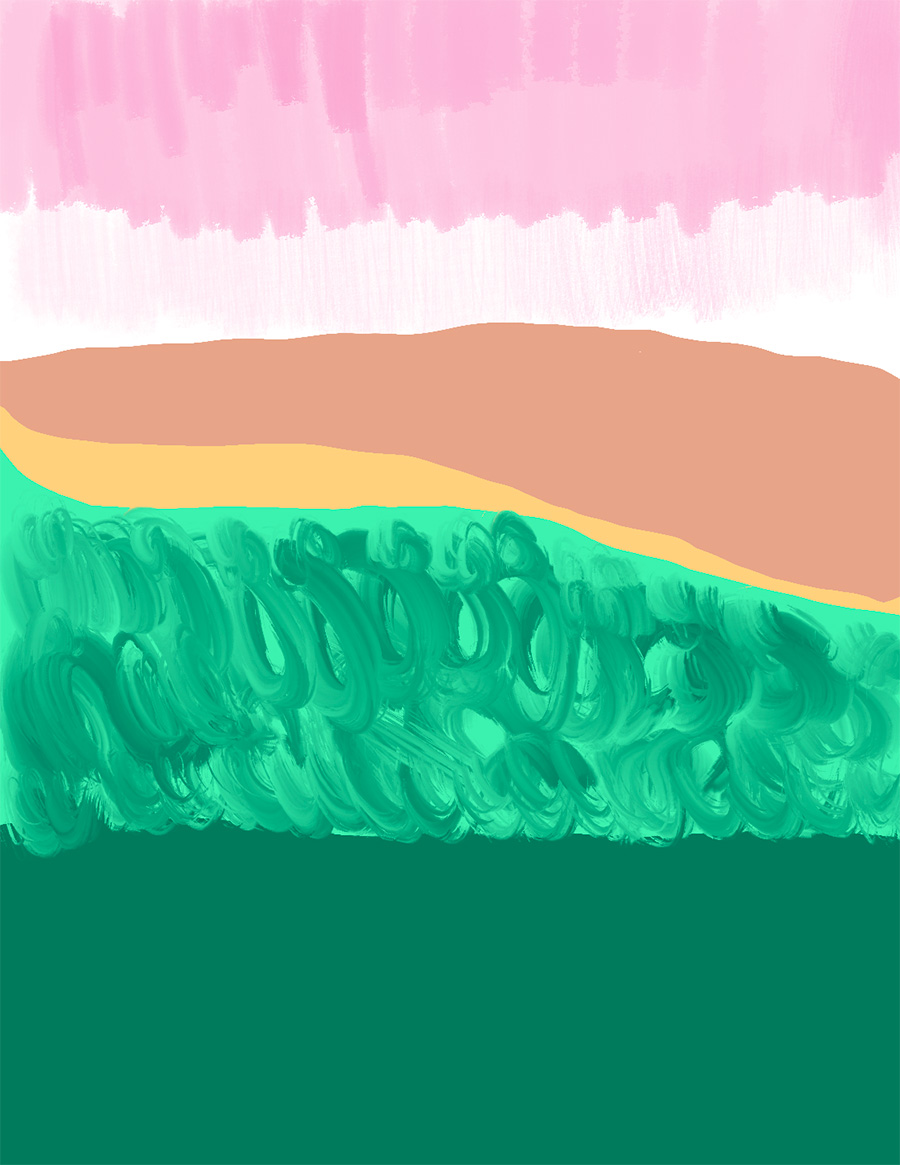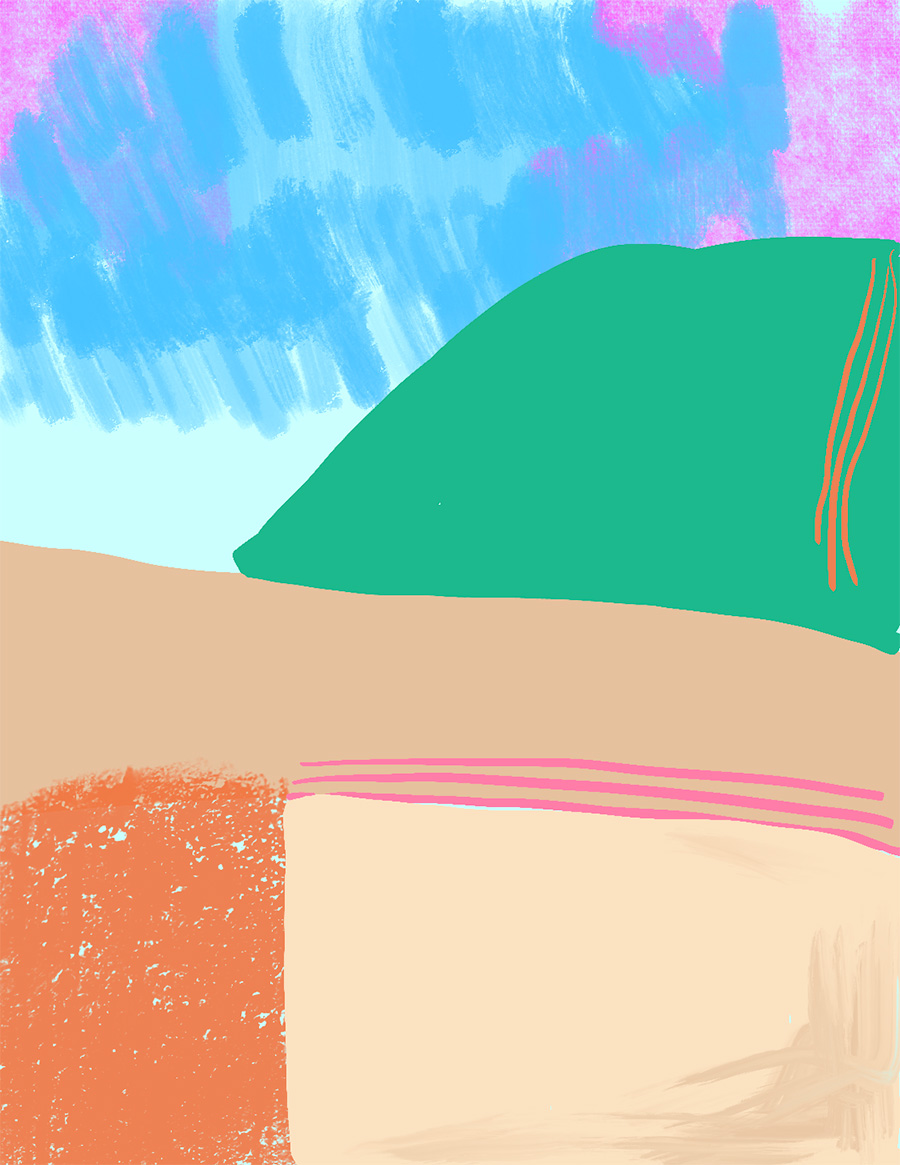Adriel Nguyen: New Work
Adriel Explores the landscape of New Haven

Artsystems Gallery is pleased to present Adriel Nguyen: New Works on view at our New York Gallery from October 21 - November 25, 2023. This presentation highlights select works as a sneak peak to our forthcoming exhibition! We invite you to explore and learn more about Adriel's time in New Haven and how it inspired her new body of work.
Nguyen is known for her paintings that combine brilliant color with fantastic landscape compositions. She draws inspiration from the landscapes of her childhood around Vung Tàu. Her family left Vietnam when she was 12 years old. She often reconnects with her homeland through family photos, stories and the occasional visit. She is interested in how landscapes shape culture, societies, and the individual person.
Adriel Nguyen’s work is in collections including The Art Institute of Chicago, San Francisco Museum of Modern Art, Brooklyn Museum, DeYoung Museum, Baltimore Museum of Art, and National Museum of Fine Arts, Santiago, Chile. She is a recipient of the Anonymous was a Woman Award. She graduates from Yale in 2012. She lives and works in Brooklyn, NYC.
Nguyen is known for her paintings that combine brilliant color with fantastic landscape compositions. She draws inspiration from the landscapes of her childhood around Vung Tàu. Her family left Vietnam when she was 12 years old. She often reconnects with her homeland through family photos, stories and the occasional visit. She is interested in how landscapes shape culture, societies, and the individual person.
Adriel Nguyen’s work is in collections including The Art Institute of Chicago, San Francisco Museum of Modern Art, Brooklyn Museum, DeYoung Museum, Baltimore Museum of Art, and National Museum of Fine Arts, Santiago, Chile. She is a recipient of the Anonymous was a Woman Award. She graduates from Yale in 2012. She lives and works in Brooklyn, NYC.
Notes from my time in New Haven
New Haven has brought to me a sense of peace due to it's slow place lifestyle. I dedicated myself to learn the history, the local haunts, the trails, the native animals and plants, as well as the people. I have always been interested in how landscapes shape people, cultures and societies.
I came here to study at Yale, but was instantly interested in everything that surrounds the university. I wanted to learn about the multiple spaces that form this city and its surrounding land. New Haven is a coastal city on Long Island Sound, in Connecticut. It’s home to the Ivy League Yale University, founded in 1701. The institution’s museums include the Yale Peabody Museum of Natural History, the Yale University Art Gallery and the Yale Center for British Art. New Haven was one of the first planned cities in the U.S.A year after its founding by English Puritans in 1638, eight streets were laid out in a four-by-four grid, creating the "Nine Square Plan". The central common block is the New Haven Green, a 16-acre square at the center of Downtown New Haven. The Green is now a National Historic Landmark, and the "Nine Square Plan" is recognized by the American Planning Association as a National Planning Landmark.
While my work typically centers around landscapes from Vietnam, a home I both know and do not know, I came to realize that while I am a student here, New Haven is my temporary home. I asked myself "how many homes can you have?", "what does it mean to have more than one home?". I wanted to dive into this new space and feel connected as deeply as I could. Often my paintings are not just simply capturing the landscape I saw, but also a night of research at the local library pouring through city records.
I came here to study at Yale, but was instantly interested in everything that surrounds the university. I wanted to learn about the multiple spaces that form this city and its surrounding land. New Haven is a coastal city on Long Island Sound, in Connecticut. It’s home to the Ivy League Yale University, founded in 1701. The institution’s museums include the Yale Peabody Museum of Natural History, the Yale University Art Gallery and the Yale Center for British Art. New Haven was one of the first planned cities in the U.S.A year after its founding by English Puritans in 1638, eight streets were laid out in a four-by-four grid, creating the "Nine Square Plan". The central common block is the New Haven Green, a 16-acre square at the center of Downtown New Haven. The Green is now a National Historic Landmark, and the "Nine Square Plan" is recognized by the American Planning Association as a National Planning Landmark.
While my work typically centers around landscapes from Vietnam, a home I both know and do not know, I came to realize that while I am a student here, New Haven is my temporary home. I asked myself "how many homes can you have?", "what does it mean to have more than one home?". I wanted to dive into this new space and feel connected as deeply as I could. Often my paintings are not just simply capturing the landscape I saw, but also a night of research at the local library pouring through city records.
Before Europeans arrived, the New Haven area was the home of the Quinnipiac, a tribe of Native Americans who lived in villages around the harbor and sustained an economy of local fisheries and the farming of maize. The area was briefly visited by Dutch explorer Adriaen Block in 1614. Dutch traders set up a small trading system of beaver pelts with the local inhabitants, but trade was sporadic and the Dutch did not settle permanently in the area.
I consider the landscape as it is now and what it might have been before those early Europeans. What did the Quinnipiac tribe experience? I found old accounts from those first Europeans but could not ignore their limited perspective on what they were documenting when they first arrived.
In 1637, a small party of Puritans reconnoitered the New Haven harbor area and wintered over. In April 1638, the main party of five hundred Puritans, who had left the Massachusetts Bay Colony under the leadership of Reverend John Davenport and London merchant Theophilus Eaton, sailed into the harbor. It was their hope to set up a theological community with the government more closely linked to the church than that in Massachusetts, and to exploit the area's potential as a port. The Quinnipiacs, who were under attack by neighboring Pequots, sold their land to the settlers in return for a pledge of protection.
I consider the landscape as it is now and what it might have been before those early Europeans. What did the Quinnipiac tribe experience? I found old accounts from those first Europeans but could not ignore their limited perspective on what they were documenting when they first arrived.
In 1637, a small party of Puritans reconnoitered the New Haven harbor area and wintered over. In April 1638, the main party of five hundred Puritans, who had left the Massachusetts Bay Colony under the leadership of Reverend John Davenport and London merchant Theophilus Eaton, sailed into the harbor. It was their hope to set up a theological community with the government more closely linked to the church than that in Massachusetts, and to exploit the area's potential as a port. The Quinnipiacs, who were under attack by neighboring Pequots, sold their land to the settlers in return for a pledge of protection.
Available Works
Adriel Nguyen
2023
Oil on canvas
40 x 30 in. (101.6 x 76.2 cm)
NGU-00008
30,000
Highlight
Checking out Peter's Rock was inspired by Adriel's hike to explore Peter's Rock in New Haven. Peter's Rock, also known as Rabbit Rock, Rabbit Hill, Indian Rock and Great Rock, with a high point of 373 feet above sea level, is a trap rock peak located 4 miles northeast of downtown New Haven, Connecticut in the town of North Haven. A group of New Haven businessmen built a hunting lodge on the summit in 1901 called The Hermitage; the lodge was abandoned during the Great Depression and fell to ruin. The only remains of the Hermitage are the ruins of the wine cellar that may be seen on one of the trails leading up to the summit.
Nguyen explored the trails by herself reading the history of the land and drawing local plants and animals she came across. It was a misty morning, and not many people where out there with her. She stopped for lunch, a picnic she brought, and painted some sketches that would later become this piece.
Nguyen explored the trails by herself reading the history of the land and drawing local plants and animals she came across. It was a misty morning, and not many people where out there with her. She stopped for lunch, a picnic she brought, and painted some sketches that would later become this piece.




